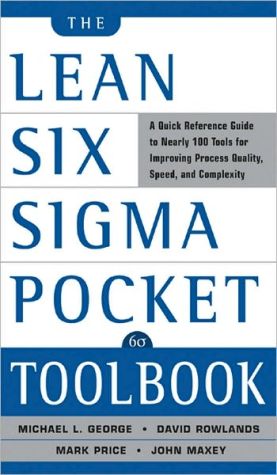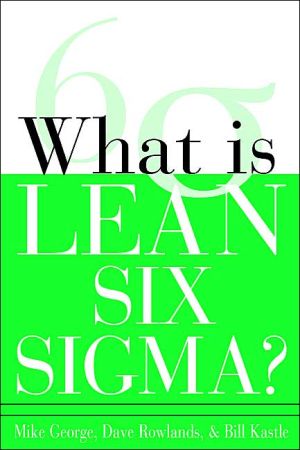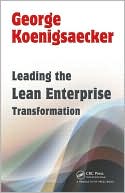Six SIGMA Statistics with Excel and Minitab
Master the Statistical Techniques for Six Sigma Operations,\ While Boosting Your Excel and Minitab Skills!\ Now with the help of this “one-stop” resource, operations and production managers can learn all the powerful statistical techniques for Six Sigma operations, while becoming proficient at Excel and Minitab at the same time.\ Six Sigma Statistics with Excel and Minitab offers a complete guide to Six Sigma statistical methods, plus expert coverage of Excel and Minitab, two of today's most...
Search in google:
Master the Statistical Techniques for Six Sigma Operations, While Boosting Your Excel and Minitab Skills!Now with the help of this “one-stop” resource, operations and production managers can learn all the powerful statistical techniques for Six Sigma operations, while becoming proficient at Excel and Minitab at the same time. Six Sigma Statistics with Excel and Minitab offers a complete guide to Six Sigma statistical methods, plus expert coverage of Excel and Minitab, two of today's most popular programs for statistical analysis and data visualization.Written by a seasoned Six Sigma Master Black Belt, the book explains how to create and interpret dot plots, histograms, and box plots using Minitab…decide on sampling strategies, sample size, and confidence intervals…apply hypothesis tests to compare variance, means, and proportions…conduct a regression and residual analysis…design and analyze an experiment…and much more.Filled with clear, concise accounts of the theory for each statistical method presented, Six Sigma Statistics with Excel and Minitab features: Easy-to-follow explanations of powerful Six Sigma tools A wealth of exercises and case studies 200 graphical illustrations for Excel and MinitabEssential for achieving Six Sigma goals in any organization, Six Sigma Statistics with Excel and Minitab is a unique, skills-building toolkit for mastering a wide range of vital statistical techniques, and for capitalizing on the potential of Excel and Minitab. Six Sigma Statistical with Excel and Minitab offers operations and production managers a complete guide to Six Sigma statistical techniques, together with expert coverage of Excel and Minitab, two of today's most popular programs for statistical analysis and data visualization.Written by Issa Bass, a Six Sigma Master Black Belt with years of hands-on experience in industry, this on-target resource takes readers through the application of each Six Sigma statistical tool, while presenting a straightforward tutorial for effectively utilizing Excel and Minitab. With the help of this essential reference, managers can: Acquire the basic tools for data collection, organization, and description Learn the fundamental principles of probability Create and interpret dot plots, histograms, and box plots using Minitab Decide on sampling strategies, sample size, and confidence intervals Apply hypothesis tests to compare variance, means, and proportions Stay on top of production processes with statistical process control Use process capability analysis to ensure that processes meet customers'expectations Employ analysis of variance to make inferences about more than twopopulation means Conduct a regression and residual analysis Design and analyze an experimentIn addition, Six Sigma Statistics with Excel and Minitab enables you to develop a better understanding of the Taguchi Method…use measurement system analysis to find out if measurement processes are accurate…discover how to test ordinal or nominal data with nonparametric statistics…and apply the full range of basic quality tools.Filled with step-by-step exercises, graphical illustrations, and screen shots for performing Six Sigma techniques on Excel and Minitab, the book also provides clear, concise explanations of the theory for each of the statistical tools presented.Authoritative and comprehensive, Six Sigma Statistics with Excel and Minitab is a valuable skills-building resource for mastering all the statistical techniques for Six Sigma operations, while harnessing the power of Excel and Minitab.
Preface ixAcknowledgments xIntroduction 1Six Sigma Methodology 2Define the organization 2Measure the organization 6Analyze the organization 11Improve the organization 13Statistics, Quality Control, and Six Sigma 14Poor quality defined as a deviation from engineered standards 15Sampling and quality control 16Statistical Definition of Six Sigma 16Variability: the source of defects 17Evaluation of the process performance 18Normal distribution and process capability ISAn Overview of Minitab and Microsoft Excel 23Starting with Minitab 23Minitab's menus 25An Overview of Data Analysis with Excel 33Graphical display of data 35Data Analysis add-in 37Basic Tools for Data Collection, Organization and Description 41The Measures of Central Tendency Give a First Perception of Your Data 42Arithmetic mean 42Geometric mean 47Mode 49Median 49Measures of Dispersion 49Range 50Mean deviation 50Variance 52Standard deviation 54Chebycheff's theorem 55Coefficient of variation 55The Measures of Association Quantify the Level of Relatedness between Factors 56Covariance 56Correlation coefficient 58Coefficient of determination 62Graphical Representation of Data 62Histograms 62Stem-and-leaf graphs 64Box plots 66Descriptive Statistics-Minitab and Excel Summaries 68Introduction to Basic Probability 73Discrete Probability Distributions 74Binomial distribution 74Poisson distribution 79Poisson distribution, rolled throughput yield, and DPMO 80Geometric distribution 84Hypergeometric distribution 85Continuous Distributions 88Exponential distribution 88Normal distribution 90The log-normal distribution 97How to Determine, Analyze, and Interpret Your Samples 99How to Collect a Sample 100Stratified sampling 100Cluster sampling 100Systematic sampling 100Sampling Distribution of Means 100Sampling Error 101Central Limit Theorem 102Sampling from a Finite Population 106Sampling Distribution of p 106Estimating the Population Mean with Large Sample Sizes 108Estimating the Population Mean with Small Sample Sizes and [sigma] Unknown: t-Distribution 113Chi Square (x[superscript 2]) Distribution 114Estimating Sample Sizes 117Sample size when estimating the mean 117Sample size when estimating the population proportion 118Hypothesis Testing 121How to Conduct a Hypothesis Testing 122Null hypothesis 122Alternate hypothesis 122Test statistic 123Level of significance or level of risk 123Decision rule determination 123Decision making 124Testing for a Population Mean 124Large sample with known [sigma] 124What is the p-value and how is it interpreted? 126Small samples with unknown [sigma] 128Hypothesis Testing about Proportions 130Hypothesis Testing about the Variance 131Statistical Inference about Two Populations 132Inference about the difference between two means 133Small independent samples with equal variances 134Testing the hypothesis about two variances 140Testing for Normality of Data 142Statistical Process Control 145How to Build a Control Chart 147The Western Electric (WECO) Rules 150Types of Control Charts 151Attribute control charts 151Variable control charts 159Process Capability Analysis 171Process Capability with Normal Data 174Potential capabilities vs. actual capabilities 176Actual process capability indices 178Taguchi's Capability Indices C[subscript PM] and P[subscript PM] 183Process Capability and PPM 185Capability Sixpack for Normally Distributed Data 193Process Capability Analysis with Non-Normal Data 194Normality assumption and Box-Cox transformation 195Process capability using Box-Cox transformation 196Process capability using a non-normal distribution 200Analysis of Variance 203ANOVA and Hypothesis Testing 203Completely Randomized Experimental Design (One-Way ANOVA) 204Degrees of freedom 206Multiple comparison tests 218Randomized Block Design 222Analysis of Means (ANOM) 226Regression Analysis 231Building a Model with Only Two Variables: Simple Linear Regression 232Plotting the combination of x and y to visualize the relationship: scatter plot 233The regression equation 240Least squares method 241How far are the results of our analysis from the true values: residual analysis 248Standard error of estimate 250How strong is the relationship between x and y: correlation coefficient 250Coefficient of determination, or what proportion in the variation of y is explained by the changes in x 255Testing the validity of the regression line: hypothesis testing for the slope of the regression model 255Using the confidence interval to estimate the mean 257Fitted line plot 258Building a Model with More than Two Variables: Multiple Regression Analysis 261Hypothesis testing for the coefficients 263Stepwise regression 266Design of Experiment 275The Factorial Design with Two Factors 276How does ANOVA determine if the null hypothesis should be rejected or not? 277A mathematical approach 279Factorial Design with More than Two Factors (2[superscript k]) 285The Taguchi Method 289Assessing the Cost of Quality 289Cost of conformance 290Cost of nonconformance 290Taguchi's Loss Function 293Variability Reduction 295Concept design 297Parameter design 298Tolerance design 300Measurement Systems Analysis-MSA: Is Your Measurement Process Lying to You? 303Variation Due to Precision: Assessing the Spread of the Measurement 304Gage repeatability & reproducibility crossed 305Gage R&R nested 314Gage Run Chart 318Variations Due to Accuracy 320Gage bias 320Gage linearity 322Nonparametric Statistics 329The Mann-Whitney U test 330The Mann-Whitney U test for small samples 330The Mann-Whitney U test for large samples 333The Chi-Square Tests 336The chi-square goodness-of-fit test 336Contingency analysis: chi-square test of independence 342Pinpointing the Vital Few Root Causes 347Pareto Analysis 347Cause and Effect Analysis 350Binominal Table P(x) = [subscript n]C[subscript x]p[superscript x]q[superscript n-x] 354Poisson Table P(x) = [lambda superscript x]e[superscript -lambda]/x 357Normal Z Table 364Student's t Table 365Chi-Square Table 366F Table [alpha] = 0.05 367Index 369








